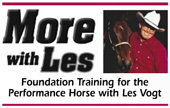 Next in a series
Next in a series
After getting relaxed in the saddle last issue, we focus on the reins
Every time you ride, be conscious of whether you’re letting your horse pull on your hands or not. There are two situations where you will feel resistance and you need to train yourself so that alarms go off in your head when they happen. First is when you pick up on a rein and feel resistance; that is, your horse doesn’t give right away to the  pressure; and second is when the horse takes the slack out of the rein and starts leaning on you. Any time you feel resistance, you need to instinctively start working the snaffle in his mouth, until the resistance goes away and he gives his head with a soft poll. You don’t have to tug or pull, just move the snaffle back and forth with enough pressure to remind your horse it’s in his best interest to give to you and soften his poll.
pressure; and second is when the horse takes the slack out of the rein and starts leaning on you. Any time you feel resistance, you need to instinctively start working the snaffle in his mouth, until the resistance goes away and he gives his head with a soft poll. You don’t have to tug or pull, just move the snaffle back and forth with enough pressure to remind your horse it’s in his best interest to give to you and soften his poll.
Since this may be a new concept to you, it’s important that you stay at it until your response is instinctive. Compare it too the way you first learned to shift your car. At first you had to think about putting in the clutch, then shifting the gear, then releasing the clutch, all without giving yourself whiplash! But after a while you were just shifting gears without really thinking about it. Until your hands respond like this to pressure from your horse, you don’t want to move ahead into any of the next levels. Keeping your horse’s neck soft and supple at all times is a cornerstone of this program, and if your horse is leaning on your hands when you ask him to do something, you need to work the bridle until he yields to the pressure, and then make sure to reward him with slack.
Good Habits: Don’t Quit at the Gate
As you get more serious about your riding you’ll find there are all sorts of magnets that will draw or repel your horse. You’ll find that he’ll easily turn towards the barn, but act like he’s only half broke when it comes to turning away from it. This presents enough of a challenge on its own, but don’t make it worse by riding him to, or even worse, out of the gate when you’re done with your session. Instead, dismount in the middle of the arena, loosen your cinch, and walk your horse out.
Editor’s Note: More with Les is a regular California Horsetrader column. Les Vogt has won more than 15 World Championships, including two wins at the NRCHA Snaffle Bit Futurity. Although Les still rides and occasionally shows, his focus is giving clinics around the world and developing products for the performance horseman. To learn more about Les and to see his clinic schedule, visit the Web site: www.lesvogt.com
Leave a Comment
All fields must be filled in to leave a message.